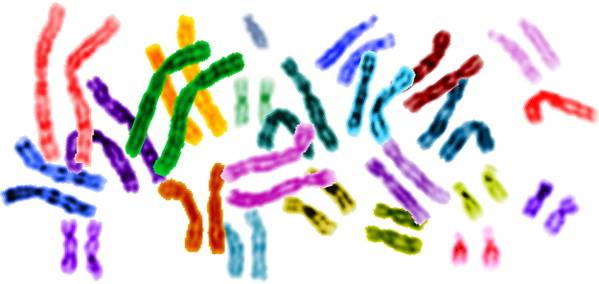Human karyotype
|
|

A picture of the human karyotype colored to show the 22 chromosome pairs. The X chromosome (red at right) and Y chromosome (blue, top center) are unpaired.
About the human karyotype
Although the same set of chromosomes is normally present in an each cell of an individual multicellular organism, eukaryotes treated as different species, even closely related ones, often have different sets. Often, when a chromosome from one such form is aligned with an otherwise identical chromosome from another, certain loci do not match. For example, a locus present in one chromosome may be absent or inverted in the other. Likewise, two otherwise identical sets of loci may occupy two different positions on the two chromosomes. Commonly, too, the loci present in a single chromosome will be shared out in blocks into two or more separate chromosomes in another organism. There may also be differences in the number of chromosomes present. Disparities of all these kinds, where the chromosomes have been restructured relative to each other, are called structural differences.
When viewed from this structural perspective, the set of chromosomes characteristic of a particular type of organism is called its karyotype, an important term in stabilization theory. As defined under stabilization theory, a karyotype is a set of chromosomes in which a particular set of loci is distributed onto particular chromosomes in a particular order and relative orientation (the DNA segments between the loci also are distributed in a particular order and orientation). Similarly, a chromosome pair is here defined as two chromosomes in the same cell that have the same set of loci, distributed in the same order and relative orientation (again, the regions between the loci are assumed to be distributed in the same particular order and orientation). With respect to the genetic information that it contains, the same locus can differ between the two members of a chromosome pair. For example, a locus for eye color on one chromosome of a pair might contain a gene for blue eyes, but contain a gene for brown eyes on the other. Such variant genes, segments of DNA differing in molecular composition but occurring at the same locus on different chromosomes, are known as alleles.
The sorts of structural differences just described distinguish, for example, the human karyotype from that of a chimpanzee (Pan troglodytes). Humans and chimpanzees do not have the same number of chromosomes and there are also differences in the structure of the individual chromosomes. The Y chromosome differs markedly in size in humans and chimpanzees. An obvious structural difference is that the equivalent of human Chromosome 2 exists as two separate chromosomes (2A and 2B) in the chimpanzee. Moreover, various other human chromosomes cannot be aligned intact with those of a chimpanzee. For example, there are regions on human chromosomes 1 and 18 that are inverted relative to the same regions on the equivalent chimpanzee chromosome. Two large inversions also distinguish a human Y chromosome from that of a chimpanzee. There are many other structural differences differentiating these karyotypes. In general, the karyotypes of more distantly related organisms are more extensively rearranged relative to each other.
Most shared on Macroevolution.net:
Human Origins: Are we hybrids?
On the Origins of New Forms of Life
Mammalian Hybrids
Cat-rabbit Hybrids: Fact or fiction?
Famous Biologists
Dog-cow Hybrids
Georges Cuvier: A Biography
Prothero: A Rebuttal
Branches of Biology
Dog-fox Hybrids